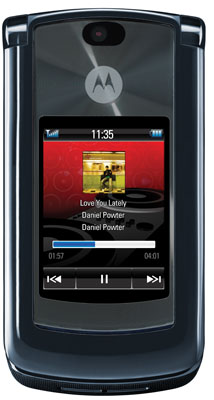Motorola ships a U.S. Linux mobile phone
Aug 7, 2007 — by LinuxDevices Staff — from the LinuxDevices Archive — 9 views SAN FRANCISCO — It finally happened. Motorola last month quietly shipped its first Linux-based mobile phone “bound for North America,” it said. Additionally, the world's third-largest handset vendor (Mot was passed up by Samsung this year) is offering new “MotoMAGX” tools to support native Linux apps.
SAN FRANCISCO — It finally happened. Motorola last month quietly shipped its first Linux-based mobile phone “bound for North America,” it said. Additionally, the world's third-largest handset vendor (Mot was passed up by Samsung this year) is offering new “MotoMAGX” tools to support native Linux apps.
digg this story |
Motorola was among the first large handset vendors to embrace embedded Linux, and has since sold 9 million Linux-based handsets globally, it claims. To date, no Linux-based Motorola phones have seen widespread distribution in the U.S., however, as far as we know.
That is about to change. The GSM/GPRS edition of the company's RAZR2 V runs Linux (CDMA versions do not), and will ship to U.S. customers — starting with a New York rollout — “very, very soon,” said Christy M. Wyatt, VP of market development. As a quad-band phone, the V8 should work fine on either T-Mobile or AT&T (formerly Cingular) networks, so presumably the phone will be available through one or both of them, although it rests with the carrier(s) themselves to make this announcement.
 The RAZR2 V8 is a highly multimedia-oriented phone, with features such as Windows Media Player 11 codec, a USB 2.0 interface supporting “high speed” (480Mbps) file transfers, and a “music touchscreen” on the external display. Additional touted RAZR2 V8 features include:
The RAZR2 V8 is a highly multimedia-oriented phone, with features such as Windows Media Player 11 codec, a USB 2.0 interface supporting “high speed” (480Mbps) file transfers, and a “music touchscreen” on the external display. Additional touted RAZR2 V8 features include:
- 512MB (420MB available) or 2GB of user storage
- External display lets users read and reply to text messages
- Quad-band GSM/GPRS support for worldwide network availability
- Two-megapixel camera with MPEG4 video capture and 8x zoom
- Stainless steel frame
- “Vacuum metal housing, chemically hardened glass, spun metal, and chrome”
- 2-inch external QVGA (320×240) 262K color external display with “contextual touch interaction”
- 2.2-inch internal QVGA 262K color display
- MotoSync OTA synch
- Optional micro-USB and Bluetooth stereo headsets
- “Full” HTML browser
- Claimed “speaker-independent” voice dialing (name or digit)
- EDGE Class 12
- Supports Bluetooth imaging, printing, peer-to-peer gaming profiles
- MMS, WV, SMS3 messaging
- Class 2, version 2.0 Bluetooth ranging up to 30 feet
- Claimed 500 minutes talk time, 280 hours standby
New developer tools
Motorola announced today that the RAZR2 V8 is based on a new Linux-based software stack dubbed “MotoMAGX,” and that it plans to aggressively market third-party development tools around the new stack.
The tools comprise a MotoDEV Studio IDE (integrated development environment) based on Eclipse and DSDP (device software development project) software. The IDE is said to support Jave ME (micro edition) development today, with two additional environments to arrive “before year's end:”
- WebUI (featuring “web technology to enable widgets and Web 2.0 experiences,” Motorola said)
- Native MotoMAGX Linux applications
In order to kickstart a third-party developer ecosystem around MotoMAGX, Motorola is hosting a “Developer Day” day-long seminar at LinuxWorld this week in San Francisco. And, it plans additional “Summit” events described as “exclusive, one-day events that offer developers technical expertise, practical advice, guidance, and a sneak peek at the next generation of Motorola devices and technology.”
Alain Mutricy, Senior VP of platform technology at Motorola, stated, “Through the introduction of our MOTOMAGX platform, we are reinforcing our firm commitment to Linux and empowering our developer community to innovate with us in exciting new ways.”
Availability
The RAZR2 V8 and MotoDEV Studio tools are available now. Pricing was not disclosed.
This article was originally published on LinuxDevices.com and has been donated to the open source community by QuinStreet Inc. Please visit LinuxToday.com for up-to-date news and articles about Linux and open source.